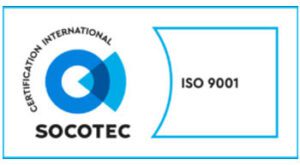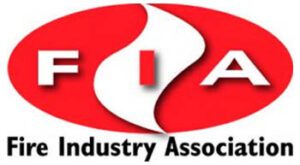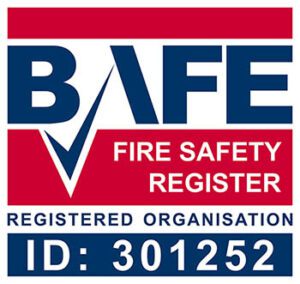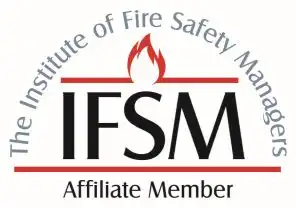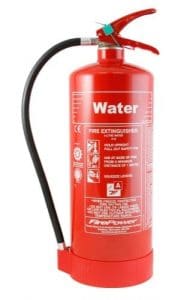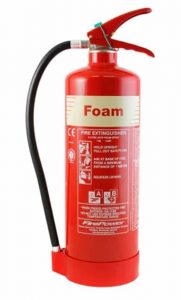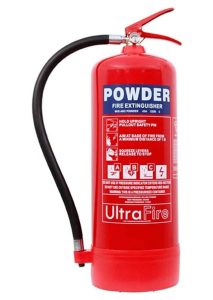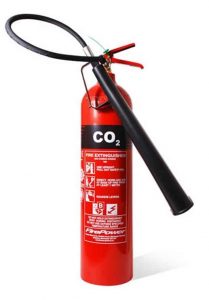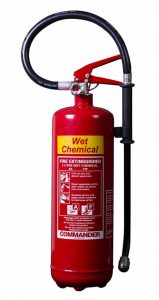There are 5 fire extinguisher colours: Red, Cream, Blue, Black, and Yellow. Each colour represents a different type of extinguisher, used on different types of fires.
The fire extinguisher colours changed in 1997 to meet British and European Standard BS EN3.
All modern fire extinguishers have a red (or chrome) body, with the identifying colour displayed in a wide band at the top of the extinguisher – as in the image below:
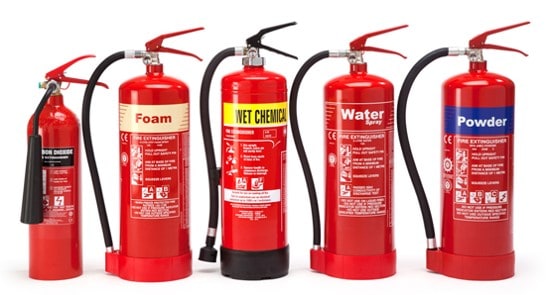
Why did the fire extinguisher colours change?
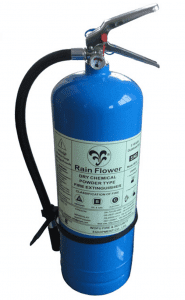
Up until 1997, the body of the extinguisher was usually made up of the entire distinguishing fire extinguisher colour.
For example, Foam extinguishers would have been completely cream, and powder extinguishers would have been completely blue.
The standard fire extinguisher colour was changed to ‘signal red’ for 2 main reasons.
Firstly, red is the colour associated with both danger and fire and so there is an obvious association with fire extinguishers.
Secondly, red is the colour most easy to see, especially in a darker environment, such as a smoke-filled room.
The only exception to the ‘red’ rule, is chrome extinguishers.
Whilst these do not strictly conform to the guidelines, all chrome extinguishers in the UK are ISO 9001 quality supervised and tested against British Standard BS EN3.
We recommend using larger extinguisher ID signs with chrome extinguishers, to make them more visible.
Summary of the different fire extinguisher colours (UK)
Fire extinguishers are available in which group of colours? It’s red, blue, black, cream and yellow. The chart below provides a quick reference summary of each of the fire extinguisher colours and the fires they tackle.
We then give you a detailed explanation of each extinguisher colour type in the following section.
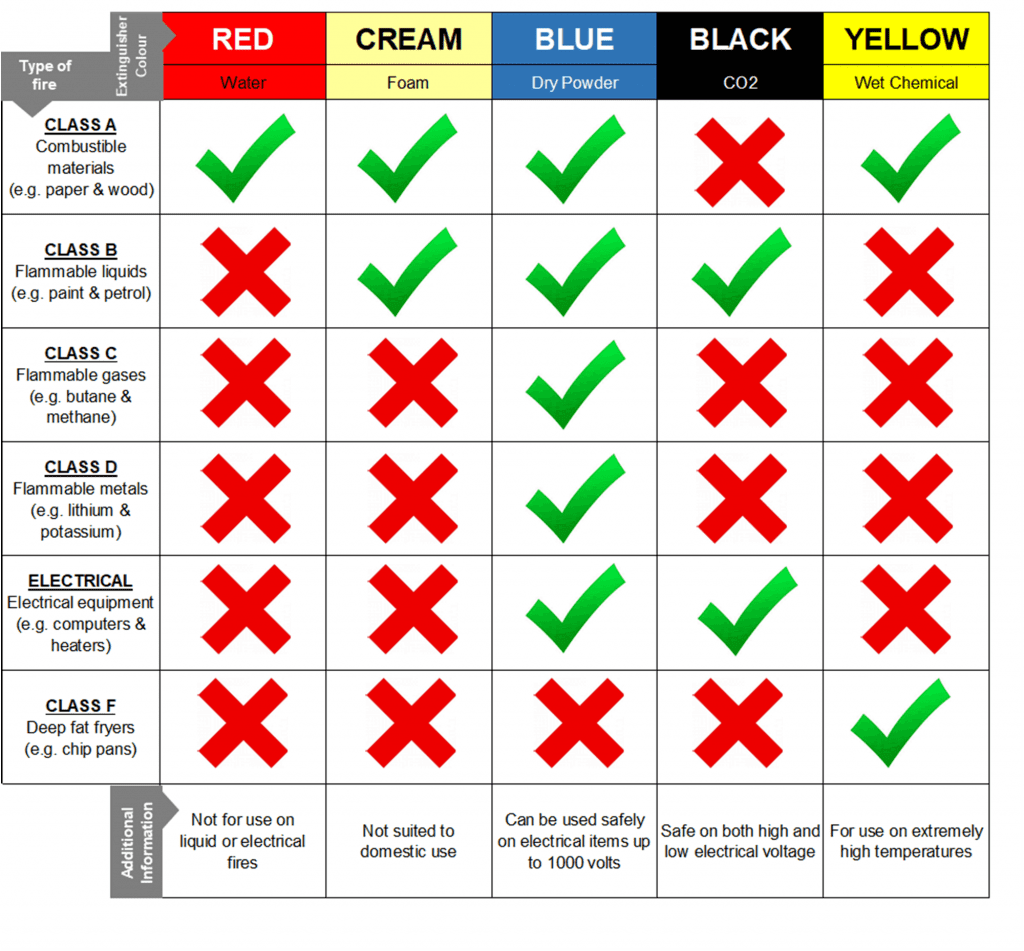
The different classes of fire
The different fire extinguisher colours tell you which classes of fire an extinguisher can be used on. Fire is a form of dry heat, but it comes in different forms.
There are six classes of fire: A, B, C, D, ‘Electrical’, and F.
Class A fires – combustible materials:
– These are fires caused by flammable solids, such as wood, paper, and fabric
Class B fires – flammable liquids:
– These are fires caused by flammable liquids, like petrol, paint, or white spirits
Class C fires – flammable gases:
– These are fires caused by flammable gases, such as hydrogen or methane
Class D fires – combustible metals:
– These are fires caused by metals and chemicals such as magnesium, or potassium
Electrical fires – electrical equipment:
– These are fires caused by electrical items, like heaters. Once the electrical item has been removed, the fire changes class, which means you can use a different colour fire extinguisher if necessary
Class F fires – cooking oils:
– Typically these are chip pan fires
Fire extinguisher colours – detailed explanation
Label Colour: Signal Red – Water Extinguishers
Overview:
Water extinguishers are the most common extinguisher for class A fires and carry the original ‘signal red’ colour label.
Used on:
o Paper and cardboard
o Fabrics and textiles
o Wood and coal
Not used on:
– Fires involving electrical equipment
– Kitchen fires
– Flammable gas and liquids
Who might need water extinguishers?:
– Buildings made of wood or another organic material
– Premises storing organic materials, like:
o Office buildings
o Schools and nurseries
o Hospitals
o Domestic dwellings
o Warehouses
It’s fair to say that the vast majority of buildings need either water or foam extinguishers.
Contact us to buy water fire extinguishers
Label Colour: Cream – Foam Extinguishers
Overview:
Foam extinguishers with their cream labels are the most common type of fire extinguisher for Class B fires. They also work on Class A fires, being water-based.
Used on:
– Organic materials like:
o Paper
o Cardboard
o Material
o Wood
o Coal
Plus:
– Flammable liquids, such as petrol, paint and turpentine
Not used on:
– Kitchen fires
– Electrical fires
– Flammable metal fires
Who might need Foam extinguishers?:
– Buildings made of wood or other organic materials
– Premises where there are organic materials to be found like:o Office buildings
o Schools and nurseries
o Hospitals
o Domestic dwellings
o Warehouses
It’s fair to say that the vast majority of buildings need either water or foam extinguishers.
Contact us to buy foam fire extinguishers
Label Colour: Blue – Dry Powder Extinguishers
Overview:
The blue-labelled dry powder extinguishers are sometimes called ‘ABC’ extinguishers because they are used on class A, B and C fires. They shouldn’t be used in enclosed spaces because the powder can be easily inhaled and the residue is very difficult to clean. Standard dry powder extinguishers can be used on some electrical fires, plus specialist dry powder extinguishers are used for fires involving flammable metals.
Used on:
– Organic materials like:
o Paper
o Cardboard
o Material
o Wood
o Coal
Plus:
– Flammable liquids, like petrol, paint and turps
Plus:
– Flammable gases, like liquid petroleum gas (LPG) and acetylene
Plus:
– Fires involving electrical equipment up to 1000v
Specialist dry powder extinguishers are only used on flammable metals, such as titanium and magnesium.
Not used on:
– Cooking oil /chip-pan fires
– Fires involving electrical equipment over 1000v
– or in enclosed spaces, such as offices or domestic dwellings
Who might need Dry Powder extinguishers?:
– Businesses who regularly use flammable gases
– Locations where flame cutting or welding is carried out
– Garage forecourts
– Buildings with large boiler rooms
Contact us to buy dry powder fire extinguishers
Label Colour: Black – Carbon Dioxide (CO2) Extinguishers
Overview:
What fire extinguisher is used for electrical fires? CO2 extinguishers. They have black labels and are mainly used for electrical fires, although they are also usually the main type of extinguisher used in computer server rooms.
Used on:
– Flammable liquids, like paint, petrol and turpentine
– Fires involving electrical equipment
Not used on:
– Kitchen fires or chip-pan fires
– Organic materials like paper, wood, cardboard or fabric
– Flammable metals
Who might need CO2 extinguishers?:
– Premises with electrical equipment, like:
o Office blocks
o Commercial kitchens
o Server rooms
o Building sites
All work vehicles should also carry a 2kg CO2 extinguisher as standard.
Contact us to buy CO2 fire extinguishers
Label Colour: Yellow – Wet Chemical Extinguishers
Overview:
Wet chemical extinguishers with yellow labels are specialist extinguishers, designed for use on fires involving cooking oils and fats (‘Class F’ fires). They can be used on Class A fires although businesses usually have a foam or water extinguisher for this purpose.
Used on:
– Chip-pan and cooking fat fires
– Organic materials like:
o Paper
o Cardboard
o Material
o Wood
o Coal
Not used on:
– Flammable liquid or gas fires
– Electrical fires
– Fires involving flammable metals
Who might need Wet Chemical extinguishers?:
– Professional kitchens
– Chippies
– Restaurants
– Canteens
Contact us to buy wet chemical fire extinguishers
We hope this guide to fire extinguisher colours has been helpful and that we answered all your questions about what colour different extinguishers are. Our guide on types of fire extinguisher may be useful too. Remember, no matter what type you have, fire extinguisher servicing is always a must.
If you still have questions, or if you’d like to book a free survey of your premises by one of our BAFE registered extinguisher engineers, please just call us on 0800 157 1113 or email us at [email protected].
Or you can ask us to call you back by clicking on the link below.

